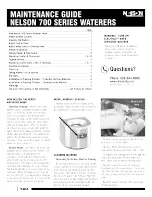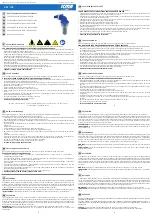
MODEL C & D
HIGH SPEED
HYDRAULIC PUMP
Read and carefully follow these instructions. Most problems with new equipment are caused by improper operation or
installation.
SAFETY PRECAUTIONS
WARNING:
To help prevent personal injury,
HYDRAULIC HOSE
●
Before operating the pump, tighten all hose connections with the proper tools. Do not overtighten.
Connections should only be secure and leak-free. Overtightening can cause premature thread failure or
high pressure fittings to split at pressures lower than their rated capacities.
●
Should a hydraulic hose ever rupture, burst, or need to be disconnected, immediately shut off the pump
and shift the control valve twice to release all pressure. Never attempt to grasp a leaking pressurized
hose with your hands. The force of escaping hydraulic fluid could cause serious injury.
●
Do not subject the hose to potential hazard such as fire, sharp surfaces, extreme heat or cold, or heavy
impact. Do not allow the hose to kink, twist, curl, or bend so tightly that the oil flow within the hose is
blocked or reduced. Periodically inspect the hose for wear, because any of these conditions can damage
the hose and result in personal injury.
●
Do not use the hose to move attached equipment. Stress can damage the hose and cause personal injury.
●
Hose material and coupler seals must be compatible with the hydraulic fluid used. Hoses also must not
come in contact with corrosive materials such as creosote-impregnated objects and some paints.
Consult the manufacturer before painting a hose. Never paint the couplers. Hose deterioration due to
corrosive materials can result in personal injury.
PUMP
●
Do not exceed the PSI rating noted on the pump nameplate or tamper with the internal high pressure
relief valve. Creating pressure beyond rated capacities can result in personal injury.
●
Before adding oil, retract the system to prevent overfilling the pump reservoir. An overfill can cause
personal injury due to excess reservoir pressure created with cylinders are retracted.
CYLINDER
●
Do not exceed the rated capacities of the cylinders. Excess pressure can result in personal injury.
●
Do not set poorly-balanced or off-center loads on a cylinder. The load can tip and cause personal injury.
POWER SUPPLY
●
All electrical work must be done by a qualified electrician.
●
Disconnect the power supply before removing the electrical box cover or performing repairs and
maintenance.
●
Never use an ungrounded (two-prong) extension cord with this unit.
Form No. 102355
2P-5500
2P-5550
4030
4031
4032
4033
4035
4036
4037
89300-00
201905
D-01023-AA
D-01026-AA
PE18 Series
Y27 Series
Operating Instructions for:
Sheet No. 1 of 4
Rev. 2 Date: 24 August 2009
SPX Hydraulic Technologies
5885 11th Street
Rockford, IL 61109-3699 USA
Tech. Services: (800) 477-8326
Fax: (800) 765-8326
Order Entry: (800) 541-1418
Fax: (800) 288-7031
SPX Corporation
655 Eisenhower Drive
Owatonna, MN 55060-0995 USA
Phone: (507) 455-7000
Tech. Services: (800) 533-6127
Fax: (800) 955-8329
Order Entry: (507) 455-1480
Fax: (800) 283-8665
International Sales: (507) 455-7223
Fax: (507) 455-7746
®
®
powerteam.com
© SPX Corporation


























